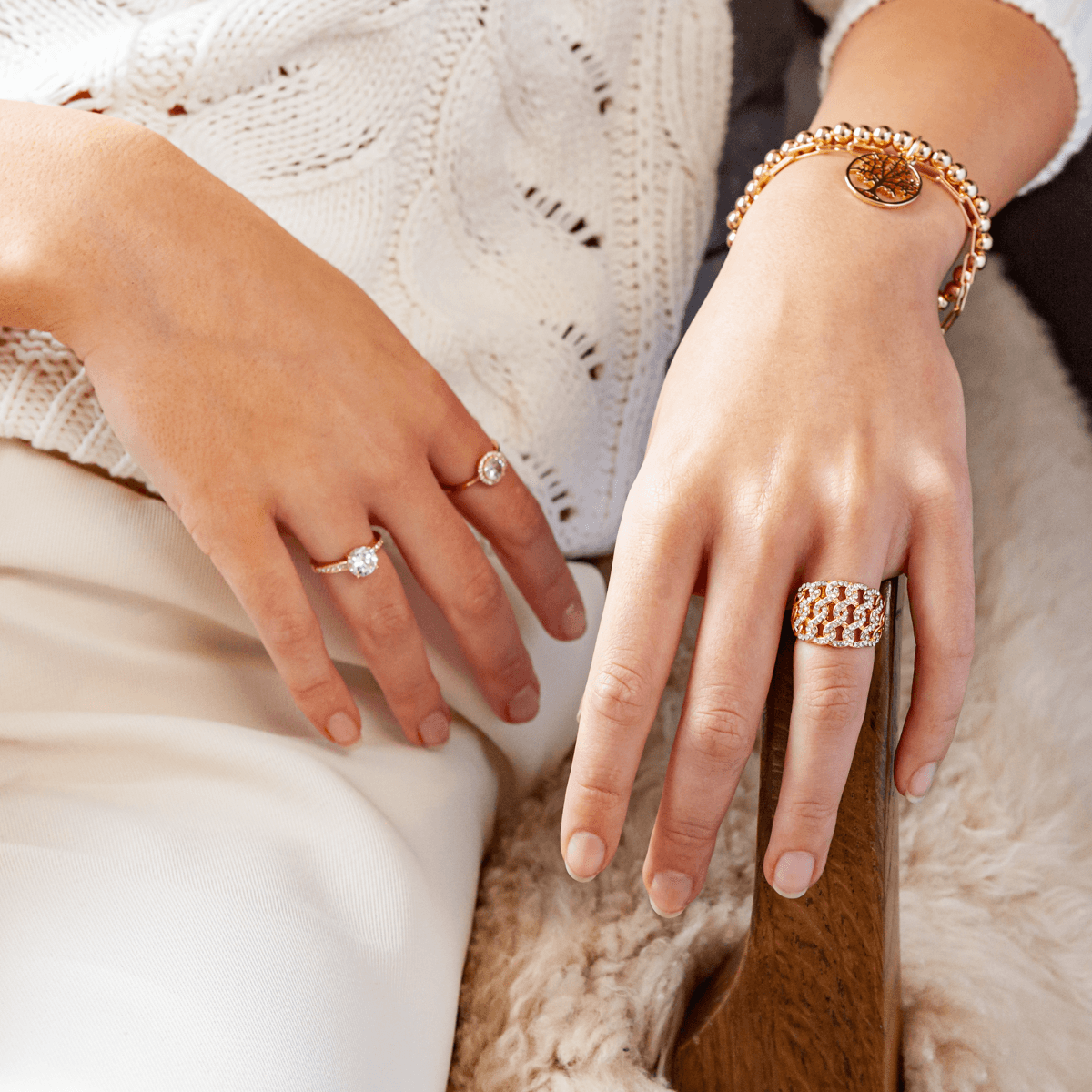In the world of jewellery, there are countless metal types that offer different benefits and unique characteristics. This guide will help you understand the most popular metals used in jewellery making and their properties, so you can make an informed decision when purchasing a new piece.
Gold
Karats
Gold is a timeless and classic choice for jewellery. However, pure gold is too soft for daily wear, which is why it is often mixed with other metals to create a more durable alloy. The gold content in these alloys is measured in karats (K).
24K Gold
24-karat gold is the purest form, with a gold content of 99.9%. While it has a beautiful, deep yellow colour, it is not practical for most jewellery pieces as it is easily scratched and bent.
18K Gold
18-karat gold contains 75% gold and 25% other metals. It offers a good balance between the rich colour of gold and added durability, making it a popular choice for high-quality jewellery.
14K Gold
14-karat gold is made up of 58.3% gold and 41.7% other metals. It is more affordable and durable than 18K gold, making it an excellent option for everyday wear.
Silver
Sterling Silver
Sterling silver is an alloy made up of 92.5% silver and 7.5% other metals, usually copper. It is a popular and budget-friendly option for jewellery, but it is prone to tarnishing and requires regular cleaning and polishing to maintain its shine.
Fine Silver
Fine silver is 99.9% pure silver, which gives it a bright, white colour. Like 24K gold, it is soft and not suitable for most types of jewellery. However, it is sometimes used for intricate, delicate pieces or those worn occasionally.
Platinum
Platinum is a rare and highly valuable metal known for its durability, resistance to tarnish, and hypoallergenic properties. Its colour is naturally white, making it an excellent choice for those who prefer a cooler-toned metal. Platinum is often used in wedding bands and engagement rings because of its strength and ability to securely hold precious stones.
Palladium
Palladium is a member of the platinum family and shares many of its properties, including durability and a naturally white colour. It is more affordable than platinum but still offers a luxurious appearance and hypoallergenic properties.
Titanium
Titanium is a lightweight, strong, and corrosion-resistant metal that has become increasingly popular for jewellery, especially wedding bands. It is hypoallergenic and comfortable to wear due to its lightweight nature. Titanium is available in various finishes and can be anodized to create a range of colours, making it a versatile option for those seeking something unique.
Tungsten
Tungsten is a dense, durable metal known for its scratch resistance and high melting point. It has a weighty feel and a sleek, polished appearance that many find appealing. Tungsten is often used in men's wedding bands and is available in various colours and finishes, including the popular gunmetal grey and black.
Stainless Steel
Stainless steel is an affordable and low-maintenance option for jewellery. It is resistant to tarnish, scratches, and corrosion. Its durability makes it an excellent choice for everyday wear, particularly for those with active lifestyles. Stainless steel has a bright, silvery-white appearance and is sometimes plated with gold or other colours for a different look.
Alloys
Gold-filled and Gold-plated
Gold-filled and gold-plated jewellery are more affordable alternatives to solid gold. Gold-filled pieces have a thicker layer of gold bonded to a base metal, making them more durable than gold-plated items. Gold-plated jewellery, on the other hand, has a thin layer of gold electroplated onto a base metal. While these options are budget-friendly, the gold layer may wear off over time, revealing the base metal beneath.
Rhodium Plating
Rhodium is a precious metal often used to plate white gold, silver, and other metals to enhance their durability, shine, and resistance to tarnish. Rhodium plating can give a piece of jewellery a high-quality, polished finish but may require occasional replating to maintain its appearance.
Vermeil
Vermeil is a type of gold-plated jewellery where a thick layer of gold is plated onto sterling silver. It offers the appearance of gold at a more affordable price point, but like other plated metals, it may wear off over time and require re-plating.
Conclusion
When choosing a metal for your jewellery, consider factors such as durability, price, appearance, and personal preferences. Each metal type offers unique benefits, so understanding their properties will help you find the perfect piece that suits your style and needs. Whether you prefer the classic appeal of gold, the cool tones of platinum, or the affordability of stainless steel, there is a metal type to suit every taste and budget.
FAQs
What is the most durable metal for jewellery?
Platinum is considered the most durable metal for jewellery due to its resistance to wear, tarnish, and scratches.
Is sterling silver a good option for everyday wear?
Sterling silver is a popular and budget-friendly option for everyday wear, but it requires regular cleaning and polishing to maintain its shine, as it is prone to tarnishing.
What is the difference between gold-filled and gold-plated jewellery?
Gold-filled jewellery has a thicker layer of gold bonded to a base metal, making it more durable than gold-plated jewellery, which has a thin layer of gold electroplated onto a base metal.
Are titanium and tungsten hypoallergenic metals?
Yes, both titanium and tungsten are considered hypoallergenic metals, making them suitable options for those with metal sensitivities.
How often does rhodium-plated jewellery need to be replated?
The frequency of replating rhodium-plated jewelry depends on factors like wear and tear, but it may be necessary every 1-3 years to maintain its appearance.

